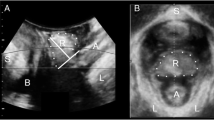Abstract
We retrospectively reviewed 106 cases of defect-directed rectocele repair. Preoperative standardized evaluation of rectovaginal septum support was performed. Support defects were identified at surgery by visually identifying breaks in the rectovaginal fascia. Clinical and surgical findings were compared using the χ2 test. Logistic regression analysis was used to identify predictive variables. Clinical examination concurred with surgical findings in 59.4% (63/106) and differed in 40.6% (43/106). Predictors of agreement between clinical examination and intraoperative findings were the presence of multiple defects in the rectovaginal fascia at surgery (OR 4.42, 95% CI 1.89, 10.35) and stage II or III prolapse (OR 0.0007, 95% CI 0.00059, 0.003 and 0.0003, 95% CI 0.00033, 0.0017, respectively). The sensitivity and positive predictive value for all defects was less than 40%. The inaccuracy of clinical examination emphasizes the need to develop new clinical and/or imaging methods to evaluate posterior vaginal support defects.


Similar content being viewed by others
References
Kahn MA, Stanton SL (1998) Techniques of rectocele repair and their effects on bowel function. Int Urogynecol J 9:37–47
Richardson AC (1993) The rectovaginal septum revisited: its relationship to rectocele and its importance in rectocele repair. Clin Obstet Gynecol 36: 976–983
Richardson AC (1995) The anatomic defects in rectocele and enterocele. J Pelv Surg 1:214–221
Cundiff GW, Weidner AC, Visco AG, Addison WA, Bump RC (1998) An anatomic and functional assessment of the discrete defect rectocele repair. Am J Obstet Gynecol 179:1451–1457
Kenton K, Shott S, Brubaker L (1999) Outcome after rectovaginal fascia reattachment for rectocele repair. Am J Obstet Gynecol 181:1360–1364
Glavind K, Madsen H (2000) A prospective study of the discrete fascial defect rectocele repair. Acta Obstet Gynecol Scand 79:145–147
Porter WE, Steele A, Walsh P, Kohli N, Karram MM (1999) The anatomic and functional outcomes of defect-specific rectocele repairs. Am J Obstet Gynecol 181:1353–1358
Cundiff GW, Nygaard I, Bland D, Versi E (2000) Proceedings of the American Urogynecologic Society multidisciplinary symposium on defecatory disorders. Am J Obstet Gynecol 182:S1–10
Altringer WE, Saclarides TJ, Dominguez JM, Brubaker LT, Smith CS (1995) Four contrast defecography: pelvic 'floor-oscopy'. Dis Colon Rectum 38:695–699
Kelvin FM, Maglinte DDT, Hornback JA, Benson JT (1992) Pelvic prolapse: assessment with evacuation proctography (defecography). Radiology 184:547–551
Brubaker L, Heit MH (1993) Radiology of the pelvic floor. Clin Obstet Gynecol 36:952–959
Kelevin FM, Maglinte DDT (1997) Dynamic cystoproctography of female pelvic floor defects and their interrelationships. Am J Radiol 19:769–774
Huddleston HY, Dunnihoo DR, Huddleston PM, Meyers PC (1995) Magnetic resonance imaging of defects in DeLancey's vaginal support levels I, II and III. Am J Obstet Gynecol 172:1778–1784
Weber AM, Abrams P, Brubaker L et al. (2001) The standardization of terminology for researchers in female pelvic floor disorders. Int Urogynecol J 12:178–186
Bump RC, Mattiasson A, Bo K et al. (1996) The standardization of terminology of female pelvic organ prolapse and pelvic floor dysfunction. Am J Obstet Gynecol 175:10–17
Shull BL (1993) Clinical evaluation of women with pelvic support defects. Clin Obstet Gynecol 36:939–951
Author information
Authors and Affiliations
Corresponding author
Additional information
Editorial Comment: The authors tackle an important question—what is the relationship between physical exam and surgical findings in the posterior wall. Their retrospective analysis of 106 patients is an important first step. There is a bit of self-fulfilling prophecy when patients are selected for a "defect-based" repair and the surgeon correlates his/her own selection. Others may wish to repeat this analysis with a series of patients, however the measure by physical exam and surgery would be masked whenever possible. The authors are encouraged to continue this important line of investigation, hopefully correlating symptoms in the near future. Clinical evaluation of posterior vaginal wall defect location is inaccurate when comparing preoperative estimation with surgical findings on defect-directed rectocele repair.
Rights and permissions
About this article
Cite this article
Burrows, L.J., Sewell, C., Leffler, K.S. et al. The accuracy of clinical evaluation of posterior vaginal wall defects. Int Urogynecol J 14, 160–163 (2003). https://doi.org/10.1007/s00192-002-1019-y
Received:
Accepted:
Published:
Issue Date:
DOI: https://doi.org/10.1007/s00192-002-1019-y




